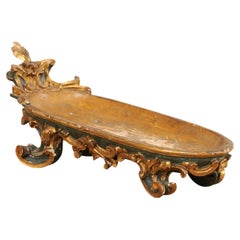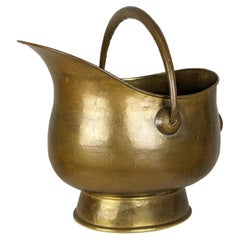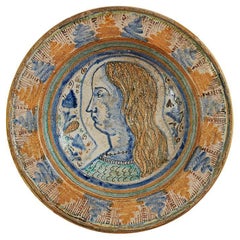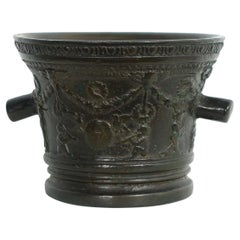Italian Bowls and Baskets
30
to
1
18
12
30
30
30
6
5
3
2
1
30
53
2,607
1,295
54
1,601
716
5
3
11
28
37
261
463
339
106
30
Height
to
Width
to
16
8
8
7
5
223,826
354
330
300
248
2
2
2
1
Period: 18th Century and Earlier
Place of Origin: Italian
Late 18th C. Italian Carved Wood Tilted Display Bowl, Approx. 2 Ft Long
Located in Atlanta, GA
An Italian carved and painted wooden bowl for display, from the turn of the 18th and 19th century. This antique bowl from Italy is oblong in shape, with front end/head tilted upward....
Category
18th Century Antique Italian Bowls and Baskets
Materials
Wood
Bronze Baluster Bowl
Located in New York, NY
Bronze baluster bowl. Antique bronze votive bowl with ten bronze balusters punctuating the outer surface in high relief. Italy 16th century.
Dimensions: 5” diameter top x 3.25" H; ...
Category
16th Century Baroque Antique Italian Bowls and Baskets
Materials
Bronze
END OF THE 15th CENTURY SMALL HAND WARM BRAZIER
Located in Firenze, FI
This small hand-warming brazier from the Renaissance era in wrought iron is a handcrafted object of great value, handmade with care and precision. The origin of this object is attrib...
Category
15th Century and Earlier Renaissance Antique Italian Bowls and Baskets
Materials
Wrought Iron
Italian MId-century Modern Brass Fireplace Carrier/magazine rack/blankets basket
Located in Varese, Lombardia
Beautiful artisanal carrier/basket for fireplace, handmade in the '60s. Made of hand-crafted hammered brass.
This conteiner is also ideal for use as a magazine rack, cache pot, or bl...
Category
1660s Mid-Century Modern Antique Italian Bowls and Baskets
Materials
Brass
16th Century Italian Maiolica Faience Dish with a Young Man Portrait
Located in Milan, IT
Mid-16th Century Italian Maiolica Dish hand-painted in blue and ocher yellow color with a profile young man portrait in the center. The maiolica col...
Category
16th Century Renaissance Antique Italian Bowls and Baskets
Materials
Maiolica
Bronze Mortar, Tuscany, Second Half of 16th Century
Located in Bruxelles, BE
Bronze mortar with garlands, flowers and putti - Tuscany , second half of 17th century.
Measures: height 10
diameter : 13 cm
Artisans and healers used mortars for grinding food...
Category
16th Century Renaissance Antique Italian Bowls and Baskets
Materials
Bronze
Antique Medieval Tuscan Mortar in Nembro Marble, Italy
Located in Roma, IT
Incredilbe apothecary Mortar in Nembro Marble, made from a single block of marble and dated back to the early 600 from Tuscany. It was used in the in apothecaries to grind herbs and spices into powder for food or medicine.
Very unique and rare piece in great conditions considering the the period to which it dates.
This highly sculptural and unique piece would be suitable today as a magnificent decoration on a table or mantle, or to grace the counter of an open kitchen...
Category
Early 18th Century Medieval Antique Italian Bowls and Baskets
Materials
Marble
18th Century Italian Berrettino Majolica Faience Riser
Located in Milan, IT
An Italian maiolica berrettino-ground riser from 18th century, central Italy, probably Faenza origin. In the central part of the riser a ruined tower is painted within a mountain lan...
Category
Mid-18th Century Rococo Antique Italian Bowls and Baskets
Materials
Maiolica
Bronze Pharmacy Mortar Italy-17° Century
Located in Brussels, Brussels
Elegant bronze mortar from the 17 century from Italy dated 1630.
Really rare mortar due to his big size.
In very good condition and beautiful patina.
Category
17th Century Renaissance Antique Italian Bowls and Baskets
Materials
Bronze
Large Antique Italian 18th Century Maiolica Faience Istoriato Plate Urbino 1790
By Urbino Workshop
Located in Portland, OR
A large & fine antique Italian maiolica Istoriato charger, Urbino, circa 1800.
This very handsome charger is hand-painted with Neoclassical nu...
Category
Late 18th Century Baroque Antique Italian Bowls and Baskets
Materials
Maiolica
Exquisite 13th Century Rock Crystal and Gold Bowl in Superb Condition
Located in London, GB
Rock crystal vessels were highly demanded and valuable in Medieval times. Inventories from European royal houses and the highest aristocratic families detail the important and sophisticated collections of ewers and bowls. Rock crystal has also been used extensively in religious art. Fine European reliquaries were also made of Rock Crystal including gems, enamel and other precious materials. The work of rock crystal is very ancient. The materials has been worked and valued for its solidity and its purity: it has been believed to be water ice permanently frozen.
Our superb example is a gold-mounted rock crystal bowl with enamel.
The items origin is not clear and various features and characteristics may lead us to think of different origins and periods of creation.
A single piece of stone mounted with gold could be a Milanese work. Although the cut could be French as similar pieces belonged to the French royalty (especially the art lover Duc de Berry, (1340-1416)). French and Italian crystal cutters have been active at the same time and it is often difficult to differentiate their works.
Islamic art also influenced European artists. The famous Fatimid treasury provided examples of their sophistication and quality. The seven ewers carved for the Fatimid Imans (known as "The Magnificent Seven") display impressive quality of both rock crystal and enamelled mounts.
Even though not identical to works by French silversmith Jean-Valentin Morel who was appointed goldsmith to Queen Victoria in 1852 or Reinhold Vasters (1927-1909) another renown German goldsmith who embellished older rock crystal items, there are similarities between these works. Both reduce their use of colour to black and white on pure gold mounts. Moreover the black enamel design is quite similar. Also, no gems are included and no human figure is represented.
Sotherby's described our bowl as a "German Rock crystal bowl with later gold mounts, 15th century." Other items from the period from Germany or Austria are usually silver mounted and the decorations are more colourful and include gems or human figures but they have in common enamel motifs.
In our case, the gold foot, handles and rim could date from the 1900s. An expert has established the foot, handles and rim are pure gold. The goldsmith responsible for the improvement of the bowl is possibly the most famous Reinhold Vasters whose work has been displayed in the greatest museums such as the V&A in London and the Metropolitan Museum of Art in New York.
The Rock Crystal bowl we have is gold mounted. The gold shows in enamelled details that are black and white. The gold handles are also enamelled with black acanthus-like leaves.
The enamelling method could be "champleve" or "painting metal". The metal that is usually preferred is copper but these techniques are also applied to gold.
The bowl itself could be from the 14th century. It's cut reminds of an estimated 14th century rock crystal ball bearing the Buoncompagni family arms...
Category
15th Century and Earlier Antique Italian Bowls and Baskets
Materials
Rock Crystal
Italian Maiolica Ancient Sugar Bowl, Lodi, 1770-1780
By Antonio Ferretti
Located in Milano, IT
Maiolica sugar bowl
Antonio Ferretti Manufacture
Lodi, Circa 1770-1780
Maiolica polychrome decorated “a piccolo fuoco” (third fire).
It measures 3.54 x 4.52 x 3.54 in (9 x 11,5 x 9 cm)
Weight: 0.394 lb (0.179 kg)
State of conservation: small and slight chips on the edges.
The small sugar bowl has a swollen and ribbed body resting on a flat base. The cap-shaped lid follows the rib of the container and is topped with a small knob in the shape of a two-colored fruit.
The sugar bowl is painted “a piccolo fuoco” (third fire) with the characteristic floral motif of bunches and isolated semis.
An example which closely corresponds to this one is kept at the Civic Museum in Lodi (G. Gregorietti, Maioliche di Lodi, Milano e Pavia, Catalogo della Mostra, Milano, 1964 n. 137).
This decorative style represented a strong point of the Lodi factory, which established itself thanks to the vivid nature of the colors made possible by the introduction of a new technique perfected by Paul Hannong in Strasbourg and later introduced by Antonio Ferretti to Italy. The production process, called “piccolo fuoco” (third fire), allowed the use of a greater number of colors than in the past; in particular, the purple of Cassius, a red made from gold chloride, was introduced. Its use allowed for many more tones and shades, from pink to purple.
The Ferretti family started their maiolica manufacturing business in Lodi in 1725.
The forefather Simpliciano started the business by purchasing an ancient furnace in 1725 and, indeed, we have evidence of the full activity of the furnaces starting from April of the same year (Novasconi-Ferrari-Corvi, 1964, p. 26 n. 4). Simpliciano started a production of excellence also thanks to the ownership of clay quarries in Stradella, not far from Pavia. The production was so successful that in 1726 a decree of the Turin Chamber came to prohibit the importation of foreign ceramics, especially from Lodi, to protect internal production (G. Lise, La ceramica a Lodi, Lodi 1981, p. 59).
In its initial stages, the manufacture produced maolicas painted with the “a gran fuoco” (double fire) technique, often in turquoise monochrome, with ornamentation derived from compositional modules in vogue in Rouen in France. This was also thanks to the collaboration of painters like Giorgio Giacinto Rossetti, who placed his name on the best specimens next to the initials of the factory.
In 1748 Simpliciano made his will (Gelmini, 1995, p. 30) appointing his son Giuseppe Antonio (known as Antonio) as universal heir. After 1750, when Simpliciano passed away, Antonio was directly involved in the maiolica factory, increasing its fortunes and achieving a reputation on a European level. Particularly important was the aforementioned introduction in 1760 of the innovative “a piccolo fuoco” (third fire) processing, which, expanding the ornamental repertoire with Saxon-inspired floral themes, was able to commercially compete with the German porcelains that had one of its most renowned offerings in the naturalistic Deutsche Blumen. Antonio Ferretti understood and promoted this technique and this decoration, proposing it in a fresher and more corrective version, less linked to botanical tables, both with or without contour lines, as well as in purple or green monochrome. After efforts to introduce more industrial production techniques to the sector succeeded, even the Ferretti manufacture, in the last decade of the eighteenth century, started heading towards decline despite its attempts to adapt production to neoclassical tastes.
In 1796 the Napoleonic battle for the conquest of the Lodi bridge over the Adda definitively compromised the furnaces. Production resumed, albeit in a rather stunted manner, until Antonio's death on 29 December 1810. (M. L. Gelmini, pp. 28-30, 38, 43 sgg., 130-136 (for Simpliciano); pp. 31 sgg., 45-47, 142-192 (for Antonio).
Bibliography
G. Gregorietti, Maioliche di Lodi Milano e Pavia Catalogo della Mostra, Milano, 1964 n. 137;
C. Baroni, Storia delle ceramiche nel Lodigiano, in Archivio storico per la città e i comuni del circondario e della diocesi di Lodi, XXXIV (1915), pp. 118, 124, 142; XXXV (1916), pp. 5-8;
C. Baroni, La maiolica antica di Lodi, in Archivio storico lombardo, LVIII (1931), pp. 453-455;
L. Ciboldi, La maiolica lodigiana, in Archivio storico lodigiano, LXXX (1953), pp. 25 sgg.;
S. Levy, Maioliche settecentesche lombarde e venete, Milano 1962, pp. 17 sgg.;
A. Novasconi - S. Ferrari - S. Corvi, La ceramica lodigiana, Lodi 1964, ad Indicem; Maioliche di Lodi, Milano e Pavia (catal.), Milano 1964, p. 17;
O. Ferrari - G. Scavizzi, Maioliche italiane del Seicento e del Settecento, Milano 1965, pp. 26 sgg.;
G. C. Sciolla, Lodi. Museo civico, Bologna 1977, pp. 69-85 passim; G. Lise, La ceramica a Lodi, Lodi 1981;
M. Vitali, in Storia dell'arte ceramica...
Category
1770s Rococo Antique Italian Bowls and Baskets
Materials
Maiolica
17th Century Casket Venetian School Laquered and Gilded Wood
Located in Milan, IT
17th century, Venetian School
Stipo - Casket
Lacquered and gilded wood, Measures: H. 46 cm; 50 x 31 cm
Elegant cabinet of imperious and noble presence. The leonine corbels highl...
Category
17th Century Antique Italian Bowls and Baskets
Materials
Wood
Large Italian Majolica Charger, circa 18th Century
Located in Bradenton, FL
A large charger with a complex scene in polychrome glazes. Hand decorated glazed earthenware, 17.5" in diameter. This style of pottery decoration, originating about 1500 in Faenza, Italy, and popular throughout the 16th century, in which paintings comparable in seriousness to Italian Renaissance easel paintings were applied to majolica ware...
Category
Early 18th Century Renaissance Antique Italian Bowls and Baskets
Materials
Pottery
19th Century Italian Majolica Dish with Renaissance Figures
Located in San Francisco, CA
19th century Italian Majolica dish with Renaissance figures
Superb highly decorated Italian Majolica plate with hand a hand painted scene of Roman mythology; The abduction of Sabine...
Category
17th Century Antique Italian Bowls and Baskets
Materials
Ceramic
Antique Hand Carved Gilt Wood Basket Dish Vide poche bowl Table Center Piece
Located in West Hollywood, CA
Antique Hand Carved Gilt Wood Basket Dish Vide poche bowl Table Center Piece
Very Early 18th Century Giltwood Italian Baroque Centerpiece . This beautiful garniture on a desk a table or a console will add instant elegance . A center piece on an entrance table . vibrant and charming . Old world charm traditional , decorative object for interior decoration design , A perfect gift during the holiday season , or special house warming present . It will be a great addition to your special collection in a library as part of the bibelot
Great shape Carved vide poche. A later copper center liner hand hammered to use as a Dresser caddy or valet tray and sundries bowl at the center . Home & Accessories collection...
Category
Early 18th Century Baroque Antique Italian Bowls and Baskets
Materials
Copper
Two Pairs of Italian Maiolica Baskets, circa 1780
By Antonio Ferretti
Located in Milano, IT
Two pairs of maiolica baskets
Antonio Ferretti Manufacture
Lodi, circa 1770-1790
Maiolica polychrome decorated “a piccolo fuoco” (third fire).
Measures: A) Height 3.54 x 6.69 x 9.84 in (9 x 17 x 25 cm);
B) Height 3.93 x 7.48 x 11.02 in (10 x 19 x 28 cm).
Total weight 4.85 lb (2.200 kg)
State of conservation:
A) One of the smaller baskets has some areas of restoration, the other slight chipping from use;
B) One of the larger baskets is intact and the other shows a clearly glued break.
The mold with which the baskets were forged simulates a wicker weave.
The two larger works have high, vertical walls, with branch-shaped handles penetrating the weave. The painted decorations, small polychrome flowers applied only externally, highlight the points where the weaves intersect.
The decision to leave the center of the basket devoid of decoration is highly unusual, but given the size and complexity of the shape, as well as the quality of the enamel, it is possible to hypothesize that it represents a precise choice in manufacturing or for a particular client.
The two smaller baskets have small, twisted handles and, on the outside, reproduce more decisively the characteristic wicker weave, obtained through thin molded lines. The interior exhibits a rich, typical decoration of naturalistic flowers: a bunch centered around a main flower and secondary stems accompanied by small “semis”. The exterior of these works is also adorned with small little flowers where the weaves intersect.
The size and morphological characteristics of the baskets confirm their attribution to the Lodi factory of Antonio Ferretti between 1770 and 1790, during its most successful period; by this point his original reworking of the "Strasbourg" decoration, known as "old Lodi", had achieved great fame even outside Italy.
This decorative choice represented a strong point of the Lodi factory, which established itself thanks to the vivid nature of the colors made possible by the introduction of a new technique perfected by Paul Hannong in Strasbourg and which Antonio Ferretti introduced in Italy. This production process, called “piccolo fuoco” (third fire), allowed the use of a greater number of colors than in the past; in particular, the purple of Cassius, a red made from gold chloride, was introduced. Its use allowed for many more tones and shades, from pink to purple.
The Ferretti family had started their maiolica manufacturing business in Lodi in 1725.
The forefather Simpliciano had started the business by purchasing an ancient furnace in 1725 and, indeed, we have evidence of the full activity of the furnaces from April of the same year (Novasconi-Ferrari-Corvi, 1964, p. 26 n. 4). Simpliciano had started a production of excellence also thanks to the ownership of clay quarries in Stradella, not far from Pavia. The production was so successful that in 1726 a decree of the Turin Chamber came to prohibit the importation of foreign ceramics, especially from Lodi, to protect internal production (G. Lise, La ceramica a Lodi, Lodi 1981, p. 59).
In its initial stages, the manufacture produced maolicas painted with the “a gran fuoco” (double fire) technique, often in turquoise monochrome, with ornamentation derived from compositional modules in vogue in Rouen in France. This was also thanks to the collaboration of painters like Giorgio Giacinto Rossetti, who placed his name on the best specimens next to the initials of the factory.
In 1748 Simpliciano made his will (Gelmini, 1995, p. 30) appointing his son Giuseppe Antonio (known as Antonio) as universal heir. After 1750, when Simpliciano passed away, Antonio was directly involved in the maiolica factory, increasing its fortunes and achieving a reputation on a European level. Particularly important was the aforementioned introduction in 1760 of the innovative “a piccolo fuoco” (third fire) processing, which, expanding the ornamental repertoire with Saxon-inspired floral themes, could commercially compete with the German porcelains that had one of its most renowned offerings in the naturalistic Deutsche Blumen. Antonio Ferretti understood and promoted this technique and this decoration, proposing it in a fresher and more corrective version, less linked to botanical tables...
Category
1770s Neoclassical Antique Italian Bowls and Baskets
Materials
Maiolica
Italy 18th Century Italy Richard Ginori Doccia Pair of Porcelain Sauce Bowls
By Richard Ginori
Located in Brescia, IT
This is an elegant pair of porcelain sauce bowls with floral drawings in red and blue.
It is beautiful for a table dressing or to collect.
The production of this well known Italian...
Category
Mid-18th Century Baroque Antique Italian Bowls and Baskets
Materials
Porcelain
18th Century Italian Majolica Faience Centerpiece Large Lodi Circular Bowl
Located in Milan, IT
18th century Italian collectible antique painted majolica bowl, a large basin-shaped centerpiece, with vertical ribs, decorated with polychrome flowers. Small chips, felure and minor...
Category
Mid-18th Century Rococo Antique Italian Bowls and Baskets
Materials
Maiolica
Late 17th-Early 18th Century Italian Majolica Bowl
Located in Hudson, NY
This good sized bowl is a great example of the majolica wares produced in Italy throughout the 15th, 16th, 17, and 18th centuries. Humble and simple but highly decorative and enterta...
Category
Early 18th Century Antique Italian Bowls and Baskets
Materials
Majolica
Neoclassical Gilt Decorated Plate With Mythological Figure
By Real Fabbrica Ferdinandea 1
Located in New York, NY
Neoclassical gilt decorated plate with mythological figure. Naples Real Fabbrica Ferdinandea white porcelain painted and gilt decorated saucer dish wi...
Category
Late 18th Century Neoclassical Antique Italian Bowls and Baskets
Materials
Porcelain
Pair of Antique Baroque Period Venetian Gilt Copper Bowls
Located in London, GB
Pair of antique Baroque period Venetian gilt copper bowls
Italian, 17th century
Dimensions: height 7cm, diameter 19cm
This rare pair of 17th century Venetian bowls...
Category
17th Century Baroque Antique Italian Bowls and Baskets
Materials
Copper
Lodi Faience Plate, circa 1770
Located in Firenze, IT
SHIPPING POLICY:
No additional costs will be added to this order.
Shipping costs will be totally covered by the seller (customs duties included).
Painted with a bird perched on flo...
Category
Late 18th Century Neoclassical Antique Italian Bowls and Baskets
Materials
Maiolica
Italy Richard Ginori 1750 Pair of Porcelain Bowls Pink Tulip Decor
By Richard Ginori
Located in Brescia, IT
Italian Richard Ginori 1750 pair of porcelain bowls with pink tulips drawings doccia
This amazing pair of Richard Ginori porcelain bowls is painted wi...
Category
Mid-18th Century Baroque Antique Italian Bowls and Baskets
Materials
Porcelain
Large Red Marble Mortar '18th Century, North Italy'
Located in Soho, London, GB
This uniquely beautiful mortar was carved from a solid block of red Verona marble (Northern Italy). On the surface of each of the four handles is carved a flower-like design. Mortars...
Category
18th Century Antique Italian Bowls and Baskets
Materials
Marble
Pair of Small White Dolphin Bowls
By Giustiniani Family 1
Located in New York, NY
Pair of small white dolphin bowls. Pair of antique Italian creamware miniature monteith bowls / bud vases supported on tripod dolphin legs on conforming stepped circular base; Giusti...
Category
Late 18th Century Neoclassical Antique Italian Bowls and Baskets
Materials
Porcelain
18th Century, Italian Venice Silver Sugar Bowl
Located in Firenze, IT
SHIPPING POLICY:
No additional costs will be added to this order.
Shipping costs will be totally covered by the seller (customs duties included).
Of circular plain form, the reeded...
Category
Mid-18th Century Louis XVI Antique Italian Bowls and Baskets
Materials
Sterling Silver
Italic Black Glazed Pottery 4th BC
Located in San Diego, CA
A rare original antique italic black glazed pottery.
Category
Early 1600s Classical Roman Antique Italian Bowls and Baskets
Materials
Terracotta
Neoclassical Gilt Decorated Plate With Puma
By Real Fabbrica Ferdinandea 1
Located in New York, NY
Neoclassical gilt decorated plate with puma. A Naples Real Fabbrica Ferdinandea white porcelain painted and gilt decorated saucer dish with puma confr...
Category
Late 18th Century Neoclassical Antique Italian Bowls and Baskets
Materials
Porcelain
Large Modernist Red Marble Vide-Poche / Inkstand
Located in New York, NY
Large Italian marble vide-poche / inkstand. Rich red and buttery gold Sicilian marble calamaio/inkwell in a very clean and modern Louis XVI form with three wells and further shallow wells for writing implements and accessories. A very rare extremely sculptural period piece, perfect for Christmas gift for the one with the big desk...
Category
Late 18th Century Louis XVI Antique Italian Bowls and Baskets
Materials
Marble
Recently Viewed
View AllMore Ways To Browse
Mategot Basket
White Candy Dish
Fish Bowl Blue
Petite Bowl
Large Green Ceramic Bowls
R Lalique Bowl
Large Antique Wicker Basket
Murano Pink And White Bowl
African Wood Bowl
Basket Of Fruit Ceramic
Retro Hanging Basket
French Antique Mortars
Woven Basket Native American
Mid Century Modern Murano Glass Leaf Ashtray
White Wicker Bedroom Furniture Used
Vintage Teak Bowl
Used White Wicker Bedroom Furniture
Fish Ceramic Bowl





